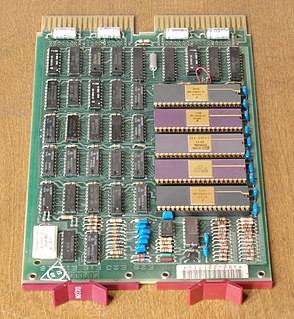Computer-generated usually refers to a sound or visual that has been created in whole or in part with the aid of computer software or computer hardware.

Computer hardware includes the physical, tangible parts or components of a computer, such as the cabinet, central processing unit, monitor, keyboard, computer data storage, graphics card, sound card, speakers and motherboard. By contrast, software is instructions that can be stored and run by hardware. Hardware is so-termed because it is "hard" or rigid with respect to changes or modifications; whereas software is "soft" because it is easy to update or change. Intermediate between software and hardware is "firmware", which is software that is strongly coupled to the particular hardware of a computer system and thus the most difficult to change but also among the most stable with respect to consistency of interface. The progression from levels of "hardness" to "softness" in computer systems parallels a progression of layers of abstraction in computing.
Computer-generated may refer to:
- Computer animation
- Computer art
- Computer graphics
- Computer-generated holography
- Computer-generated imagery (CGI)
- Computer-generated music

Computer animation is the process used for generating animated images. The more general term computer-generated imagery (CGI) encompasses both static scenes and dynamic images, while computer animation only refers to the moving images. Modern computer animation usually uses 3D computer graphics, although 2D computer graphics are still used for stylistic, low bandwidth, and faster real-time renderings. Sometimes, the target of the animation is the computer itself, but sometimes film as well.
Computer art is any art in which computers play a role in production or display of the artwork. Such art can be an image, sound, animation, video, CD-ROM, DVD-ROM, video game, website, algorithm, performance or gallery installation. Many traditional disciplines are now integrating digital technologies and, as a result, the lines between traditional works of art and new media works created using computers has been blurred. For instance, an artist may combine traditional painting with algorithm art and other digital techniques. As a result, defining computer art by its end product can thus be difficult. Computer art is bound to change over time since changes in technology and software directly affect what is possible.

Computer graphics are pictures and films created using computers. Usually, the term refers to computer-generated image data created with the help of specialized graphical hardware and software. It is a vast and recently developed area of computer science. The phrase was coined in 1960, by computer graphics researchers Verne Hudson and William Fetter of Boeing. It is often abbreviated as CG, though sometimes erroneously referred to as computer-generated imagery (CGI).
| This disambiguation page lists articles associated with the title Computer-generated. If an internal link led you here, you may wish to change the link to point directly to the intended article. |






